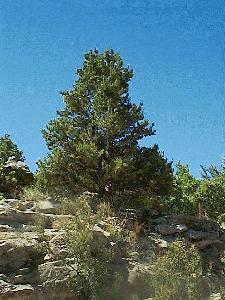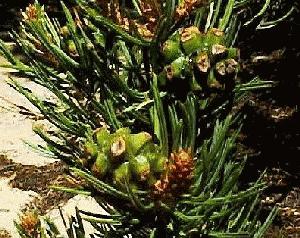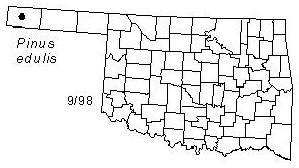

Small bushy pine tree to 6 m (20 ft) tall and 20 cm (8 in) diameter, with a short trunk and rounded open crown. Bark gray to reddish-brown, rough, divided into scaly ridges. Twigs thin, gray, resinous. Buds light brown, with numerous small scales. Leaves (needles) 2-4 cm (0.8-1.6 in) long, two in a bundle, remaining attatched for several years, bundle-sheath falling at end of first year. Cones egg-shaped, 4-5 cm (1.5-2 in) long, pale brown, usually resinous and sticky, with thick blunt scales, maturing in two years. Seeds oblong, wingless, about 12 mm (0.5 in) long.
Distribution: Native to the Southern Rocky Mountain region.
Habitat: Mesas and mountain slopes from about 1200 to 2400 m (4000-8000 ft).
NWI status: none
Comment: Piñón is the state tree of New Mexico. The trees are too small for sawlogs, but the wood is used extensively for fuel in the Southwest. The seeds (called piñones or pine nuts) are an important nut crop in Colorado, New Mexico, and Arizona. Pinus is the ancient Latin name for the pines; edulis may refer to the large edible seeds.
Distribution in Oklahoma: 
BACK
NEXT
RETURN TO INDEX
Last update: 9/15/99
 Go to Oklahoma Biological Survey Home Page
Go to Oklahoma Biological Survey Home Page
 Disclaimer
Disclaimer